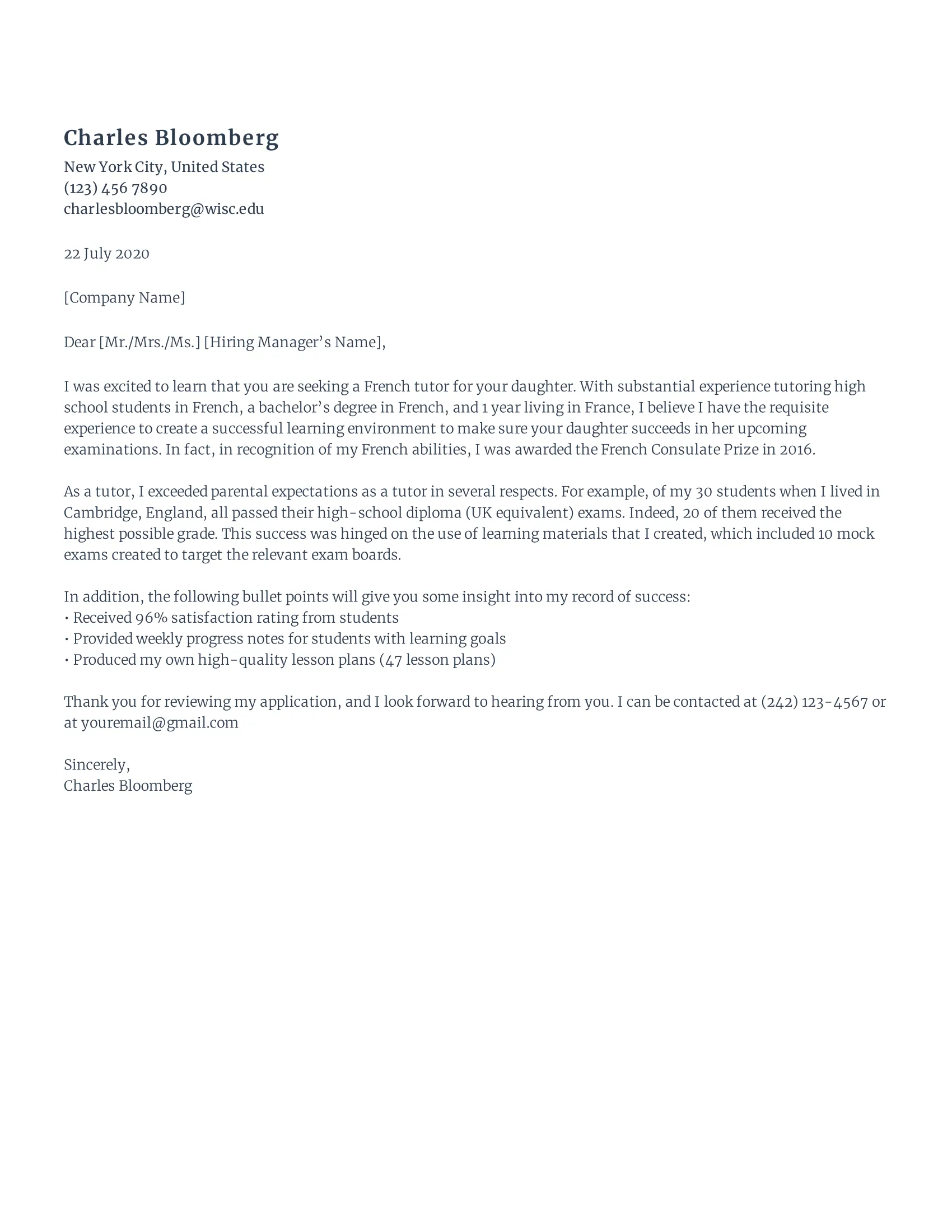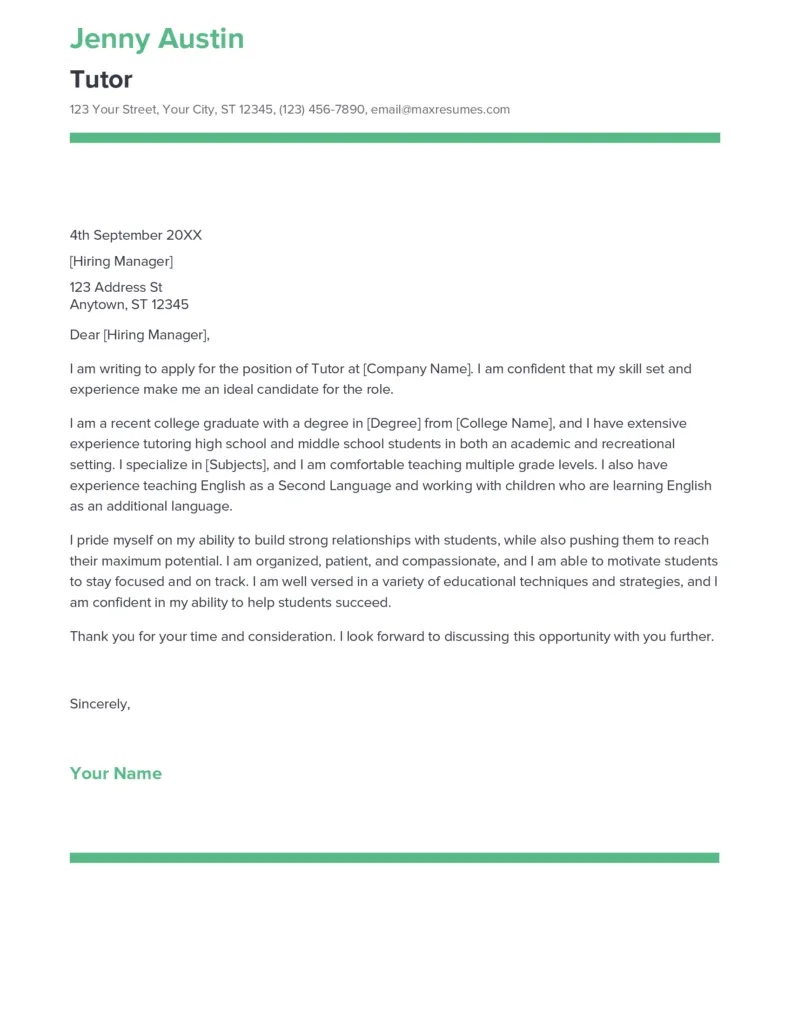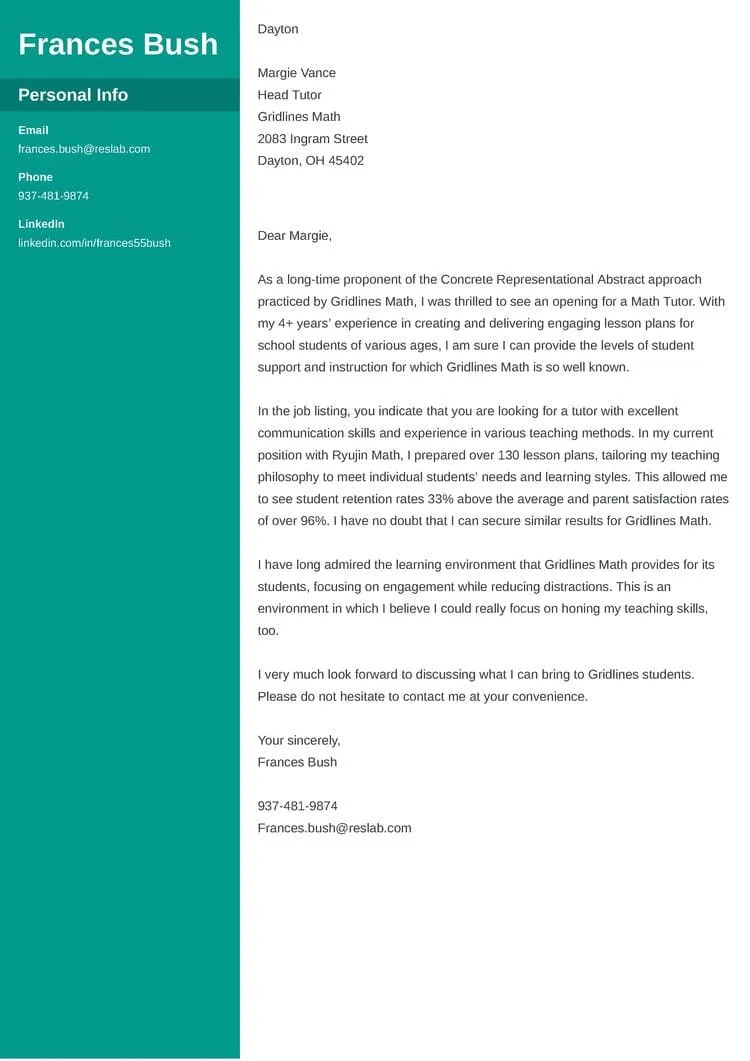Understanding the Purpose of a Tutoring Cover Letter
A cover letter for a tutoring job is your first introduction to a potential employer. It serves as a crucial document that complements your resume, offering a deeper insight into your qualifications, skills, and passion for tutoring. Unlike a resume, which provides a factual overview of your experience, a cover letter allows you to express your personality, explain your motivations, and demonstrate how your skills align with the specific needs of the tutoring position. It’s your opportunity to make a strong first impression and convince the hiring manager that you are the ideal candidate. A well-crafted cover letter not only highlights your relevant experience but also showcases your communication skills and enthusiasm for helping students succeed. It sets the stage for a successful application and increases your chances of landing an interview.
Key Components of a Successful Tutoring Cover Letter
A successful tutoring cover letter must include several key components that effectively communicate your qualifications and suitability for the role. Begin with a professional heading that includes your contact information and the date, followed by the recipient’s information. The opening paragraph should clearly state the position you’re applying for and how you learned about it. The body of the letter should then delve into your relevant experience, skills, and accomplishments, providing specific examples to illustrate your capabilities. It should articulate your understanding of the specific tutoring position and showcase what makes you the right person for it. Finally, the closing paragraph should express your enthusiasm for the opportunity, reiterate your interest in the position, and include a call to action, such as requesting an interview. Remember to keep the tone professional and enthusiastic throughout, tailoring your letter to the specific requirements of the job description.
Personalizing Your Cover Letter for Tutoring Jobs

Personalizing your cover letter is a vital step in making it stand out from the competition and demonstrates your genuine interest in the tutoring position. Avoid sending generic cover letters, as they often fail to capture the reader’s attention. Instead, take the time to research the specific tutoring position and the institution offering the job. Show that you understand the needs of the students and the goals of the tutoring program. By tailoring your letter to the specific requirements outlined in the job description, you can highlight the skills and experience that are most relevant to the role. Furthermore, personalizing your letter allows you to express your unique qualities and the value you can bring to the team, making you a more compelling candidate. This shows initiative, and a keen eye to detail that is essential for the job.
Researching the Tutoring Position and Institution
Before you start writing your cover letter, conduct thorough research on both the tutoring position and the institution. Understanding the specifics of the role, such as the subjects you’ll be tutoring, the age group of the students, and the teaching methodologies used, will enable you to tailor your letter to the job requirements. Explore the institution’s website to learn about its mission, values, and any specific tutoring programs they offer. This research allows you to address the specific needs of the institution, demonstrating your understanding of their requirements. Mentioning the institution’s specific goals and programs in your letter shows that you’ve taken the initiative to understand their unique needs. This tailored approach shows that you are genuinely interested in the opportunity and that your skills align with the institution’s objectives, increasing your chances of getting noticed.
Highlighting Relevant Skills and Experience
When highlighting your skills and experience in your cover letter, focus on those that are most relevant to the tutoring position. Carefully review the job description and identify the key skills and qualifications that the employer is seeking. Provide specific examples of your experience that demonstrate how you’ve successfully used these skills in the past. Consider including examples of your experience teaching, mentoring, or helping others learn. If you have experience tutoring a specific subject or age group, make sure to highlight that experience in your letter. Provide data or specific examples where possible, like student performance improvements or the positive impact you had on students. This demonstrates to the potential employer that you have the skills and qualifications that are needed to succeed. It shows that you have the necessary capabilities to handle the demands of the role.
Quantifying Your Accomplishments and Results

Quantifying your accomplishments and results is an effective way to demonstrate the impact of your tutoring efforts. Instead of just stating that you are a good tutor, provide specific examples of the results you have achieved. For example, if you have helped students improve their grades, mention the percentage increase in their scores. If you have helped students develop specific skills, provide evidence to show you were successful. By providing metrics and data, you make your accomplishments more tangible and credible. This approach helps employers understand the value you can bring to their tutoring program. Quantifying your achievements is crucial in showing that your tutoring experience has yielded measurable outcomes. This approach helps in the evaluation of potential effectiveness, making you a more competitive candidate.
Showcasing Your Passion for Tutoring
Demonstrating your passion for tutoring is essential in making your cover letter compelling and memorable. Express your enthusiasm for helping students succeed and highlight your commitment to education. Share your personal motivations for becoming a tutor and what inspires you to support students in their learning journeys. Show your genuine interest in helping students overcome academic challenges and reach their full potential. Explain the rewards of tutoring and express your enjoyment. The more enthusiasm you have for your role the better impression you will make on the employer and the higher your chances of getting the job. It also makes you sound more confident and approachable to potential students. Let your passion shine through, as it will resonate with potential employers.
Tailoring Your Tone and Style
The tone and style of your cover letter should be professional, yet personable, to showcase your communication skills. Tailor your language to match the tone of the institution. If it’s a more formal institution, maintain a professional tone. If the environment is more informal, you can be more relaxed. Be positive and enthusiastic, and make sure your letter reflects your personality. Use clear, concise language and avoid jargon. Choose a font that is easy to read and use proper grammar and spelling. The tone is your chance to show your communication skills, and make your application more personable. By tailoring your approach to the individual company it will increase your chances of getting noticed, and highlight your genuine interest in the position.
Formatting and Proofreading Your Cover Letter

Proper formatting and proofreading are crucial for creating a professional and polished cover letter. The format of your cover letter is the first thing a hiring manager will see, so it’s important to make a good impression. Proofreading ensures that your letter is free of errors. These steps reflect your attention to detail and commitment to quality. Pay attention to these details to showcase your professionalism and increase your chances of getting hired. The format provides a quick overview of your skills, and the employer knows what to expect. Errors can be off-putting, and prevent you from getting selected.
Essential Formatting Tips
Use a professional font such as Times New Roman, Arial, or Calibri. Ensure the font size is readable, typically between 11 and 12 points. Use standard margins of 1 inch on all sides. Keep your letter concise, ideally one page in length. Use clear and organized paragraphs, with appropriate spacing between them. Use bolding to highlight key skills or accomplishments. Include your contact information at the top of the letter. Follow these essential formatting tips to make your cover letter easy to read and visually appealing.
Proofreading Techniques to Avoid Errors
Proofreading is a crucial step to ensure your cover letter is free of errors. Read your letter multiple times, checking for spelling, grammar, and punctuation errors. Use a spell-checker and grammar-checker tool. Read your cover letter aloud to catch any awkward phrasing or sentence structure. Ask a friend or family member to proofread your letter. Proofreading ensures that your cover letter is polished and error-free. A well-proofread letter will demonstrate your attention to detail, increasing the likelihood of a positive impression and being selected for an interview.
Following Up After Submitting Your Application

After submitting your cover letter and resume, it’s good practice to follow up with the hiring manager. Within one to two weeks, send a brief email or make a phone call to inquire about the status of your application. Express your continued interest in the position and reiterate your qualifications. This follow-up demonstrates your enthusiasm and proactive approach. It shows that you are serious about the opportunity. A simple follow-up can often make a lasting impression on the hiring manager. Following up helps you make sure your application has been received and reviewed.
